To a survivalist, insects are a boon.
Truly a part of the food chain, insects have their own hierarchy within their domain of what eats what. Most preppers already understand that ladybugs and praying mantises eat typical garden pests.
Moreover, without insects, flowers don’t pollinate and decaying matter doesn’t decompose. The lowliest mosquito, cockroach, and silverfish sustain the lives of other animals in our ecosystem, so think twice before squashing one.
Unless you’re planning on frying them up in a pan, there really is no reason for killing any bugs on your property.
Related: Bugs You Can Eat in a Food Crisis
Pest Control
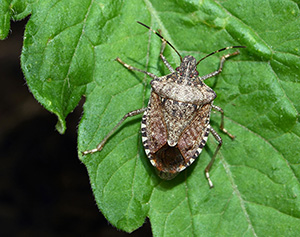 1. Stink Bugs: Stink bugs are beneficial outside the house in that they eat other insects that are known for destroying crops.
1. Stink Bugs: Stink bugs are beneficial outside the house in that they eat other insects that are known for destroying crops.
If for some reason these invade your home, squashing them or vacuuming them up can cause pheromones to release. Consequently, more stink bugs will appear.
There are differences between good and bad stink bugs, and some look a lot alike. Figure out how to tell the difference between good stink bugs and bad stink bugs before reaching for your coffee grounds or essential oil sprays.
2. Antlions and Doodlebugs:
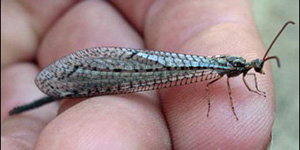
Antlions feed on ants, but their four-and-a-half-inch wingspan is intimidating.
Larval antlions dig holes in the ground and wait for ants to fall in before snatching them up with their huge jaws.
Due to the fact that ants are their main food source, antlions and doodlebugs are most definitely good to have around.
3. House Centipedes: Multi-legged, feathery, freaky fast, and extremely undesirable in bathtubs, where they are commonly found.
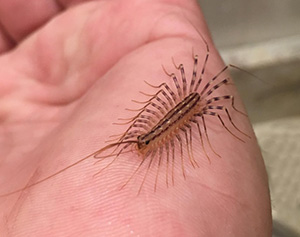
These guys serve the underbelly of your home, and eat a lot of other insects, including cockroaches and moths.
Relocating these speedy bugs is next to impossible, so steer them towards any cracks leading from your home’s interior.
They eat nocturnal bugs, which is a good thing to keep in mind.
4. Mealybug Destroyer: Oftentimes mistaken for the invasive mealybug this insect feeds upon, the destroyer has curly tentacles or appendages from its dark body.
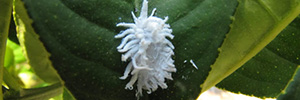 Mealybugs are almost all white and have a long tail. As a matter of fact, mealybug destroyers consume mealybugs in every stage of the mealybug life cycle.
Mealybugs are almost all white and have a long tail. As a matter of fact, mealybug destroyers consume mealybugs in every stage of the mealybug life cycle.
Most insects prefer their prey either in the larval stage or adult stage. The destroyer will take them all. Mealybug destroyers also control aphid populations, which is a gardener’s delight.
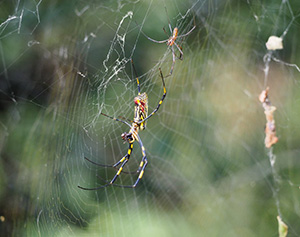
5. Spiders: Never a fun find inside the home, yet they are super helpful outdoors. Spiders make great predators of pesky bugs that destroy gardens and foliage. They also go after mosquitoes and moths.
Jumping spiders eat their prey alive, so jump out of their way when you see them outside.
Long-legged cellar spiders eat black widows and other spiders.
Related: Spider Hole Tactics to Defend Against Looters
6. Parasitic wasps:
Wasps like braconid wasps go after hornworm caterpillars, which destroy tomato plants.
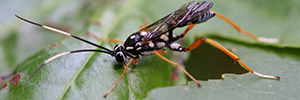
Trichogamma wasps lay their eggs inside the eggs of over 200 varieties of insect pests.
They are actually really small, so they are easy to differentiate from more threatening wasps.
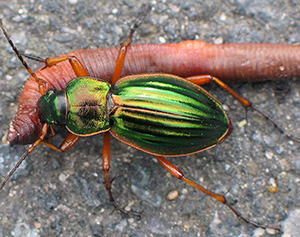 7. Ground beetles: Not only is this broad category of insects helpful in eradicating insect pests and slugs, but they also feed on unwanted weeds.
7. Ground beetles: Not only is this broad category of insects helpful in eradicating insect pests and slugs, but they also feed on unwanted weeds.
Without these weed seed predators, weeds can propagate 30% more on a farm. Due to their omnivorous nature, they are helpful in eradicating either pesky insects or unwanted weeds.
When one type of food isn’t abundant, they go after the other. Unfortunately, some good beetles eat other beneficial bugs/beetles, which can become destructive in a large garden or farm.
8. Green lacewings:
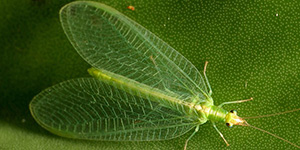
Often intentionally released into gardens to naturally assist in pest control, green lacewings voraciously eat everything you want them to and nothing you don’t.
With their lacy wings and golden orb eyes, these good guys are fun to observe.
9. Bees and other stinging insects: Bees, wasps, and hornets have a special position in the insect kingdom. They are all important pollinators and are typically benign.
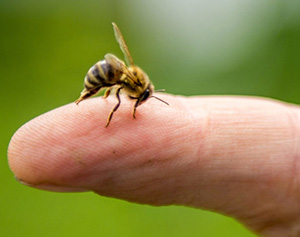
Bumblebees and honeybees are the most beneficial and least aggressive.
Yellow jackets or “meat bees” are perhaps the most annoying perpetrators at your barbeque, but they still have their place in the ecosystem.
Without them, we’d have a heck of a lot more pests around.
There are plenty of ways to keep bees away from your summer picnic without killing them.
10. Assassin Bugs: Assassin bugs inject venom into their prey, and make for fantastic natural pest control. They get rid of unwanted flies, mosquitoes, and aphids.
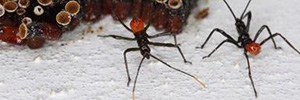 Their bite is harmful to humans, and typically occurs when handled. Moral of the story? Don’t touch them when you see them on your property!
Their bite is harmful to humans, and typically occurs when handled. Moral of the story? Don’t touch them when you see them on your property!
Pollinators
Flies, moths, butterflies, and beetles are equally if not more important than bees when it comes to pollinating crops.
Ants and wasps also make great pollinators.
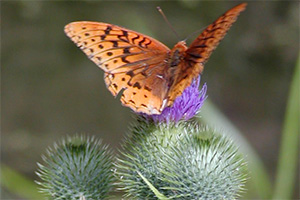 All of these insects visit various parts of flowers, picking up pollen along the way.
All of these insects visit various parts of flowers, picking up pollen along the way.
Because of this, the quality and quantity of pollination services naturally increase.
Non bee pollinators are a perfect supplement to bees, but not a substitute for bees.
The ideal pollination of crops occurs with a diverse group of insect visits.
Related: How to Start a Beehive
Decomposers
Worms, flies, millipedes, and sow bugs are essential for breaking down dead or dying plant matter. Dung beetles are an excellent example of a beneficial insect performing the job nobody else wants!
They disperse seeds from clumps of feces in the process of collecting dung to feed their larvae.
Bugs You Can Eat
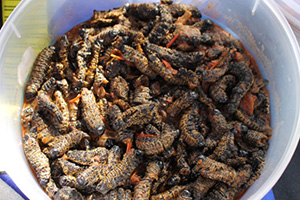 Survivalists are very good at recognizing lifesaving behavior. Eating insects could most very well nourish your family when other choices aren’t available.
Survivalists are very good at recognizing lifesaving behavior. Eating insects could most very well nourish your family when other choices aren’t available.
Crickets, cicadas, ants, beetles, grubs, and grasshoppers are most commonly eaten anywhere outside the U.S. and Europe.
You should cook your insects to make the experience more safe and enjoyable.
Never eat caterpillars, snails, or slugs, unless you know what they’ve been noshing on. Cooking them doesn’t always eradicate toxins, so your best bet is to stick with the safe list of known beneficial bugs.
Seeing opportunity and embracing unpopular behavior is just something preppers step to with grace. A good relationship and knowledge of insects on your property will automatically make you a better prepper.
Insects are naturals at pest control, pollination, seed dispersal and decomposition. Watching them at work is an inspiration and can be very entertaining.
When you can observe all the unique types of life on your land, respect for them naturally follows.
You may also like:
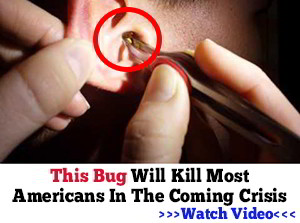 Baking Soda – 112 Uses (WWII Series)
Baking Soda – 112 Uses (WWII Series)
The Berry That Is Illegal To Grow, But Perfectly Fine To Forage (Video)

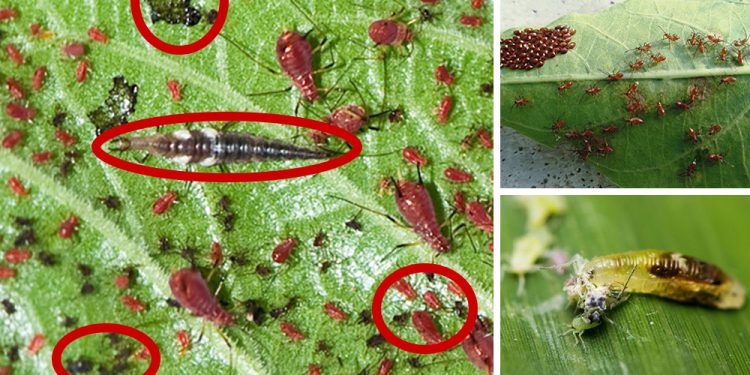













I love the things i learn from ur emails bless u claude
Pictures of each bug would sure be helpful!
That really depends on where you live as almost every species of bug has so many variations especially depending on their environment.
Ill give you a personal example.
I grew up in Florida, and we have alot of Dragonflies ( Another beneficial bug ) Now Florida dragonflies have alot of different colors with metallic blues and greens over here in the states.
Yet when I was in Iraq, the dragonflies I saw near the Tigris river were sand colored.
So dependent on not only WHERE you live, there is also what locals call them. Rolly pollys or pill bugs. Lightning bugs or fire flies. Cock roach, water bug, or wood roach. Sofa, Couch or Davenport. And of course here in the south coke, coke or coke.
Thank you for that great explanation! I know just enough to know I can look up “stink bug” and not find MY stink bugs.
I just didn’t think it through quite far enough (maybe because I don’t like thinking about bugs a whole lot!)
I decided 18 years ago to use no pesticides, organic or chemical, on my property. The one exception is spraying the tomatoes in the vegetable garden with Bt once or twice in the spring, but I always plant a few tomatoes around the house that don’t get sprayed because the hornworms make such cool moths. All the beds are planted for butterflies and hummingbirds, for example the butterflies and hummers both like to nectar at Mexican Milkweed, and the monarch caterpillars eat the leaves. A while back aphids got on the milkweed and started to ruin their flowers. I thought about spraying the little fellers but held off, next day monarch caterpillars hatched out and started eating all the plants anyway. My unsprayed beds are little zoos, cottontails, shrews, anoles, geckoes, leopard frogs, barking tree frogs and various toads, various little sparrows, snakes, spiders, scorpions, parasitic wasps, grasshoppers, and hair trigger paper wasps.
No chemicals here either. I love the variety of insects. I brought in a plant a few days ago. Now I have a praying mantis inside. Lol. Its an interesting insect. So are walking stick insects. Glad there aren’t many mosquitos.
I’m thinking your preying mantis would enjoy to have a few superfluous mosquitoes for the occasional snack. . .
Any bugs that come in my house usually wind up being eaten by my cat – I don’t swat anything anymore but I will centipedes and millipedes because they’re poisonous… and I always wipe up the goo, regardless.
Good Info…
I was on my HS FFA Entomology (study of insects, bugs, non-insects like spiders) team. If you have ever been involved in entomology, you will agree that we have aliens living on our planet right now…lol.
For the most part, all insects serve a purpose, but a bunch are considered pests. The worst pests that you should avoid or exterminate are the blood suckers, and they are everywhere. These are the notable ones and I believe all of them can transmit pathogens, except for one…any guesses?
ticks, mosquitos, bed bugs, lice, horse flies, fleas
Well, here’s a hint…it usually bites/sucks you three times in a row on your skin, leaving three red dots in a 1 inch line. And they feed only at night, while you are sleeping (BB).
J. Quest:
Actually, bed bugs can be carriers of Chagas disease.
https://www.sciencedaily.com/releases/2014/11/141117174328.htm
It’s a South American disease carried by kissing bugs, but bed bugs can carry it too.
Ick!
Ahhh, Had not heard about that one.
Makes sense…they feed on blood.
Thank You for the update.
Places like Chicago and New York where the masses of illegals from Africa and South America wind up are having bed bug infestations. Most hotels that are forced to house these invaders throw out their mattresses and carpets once the hordes of pre-democrats are sent to fend for themselves.
I certain the common household fly has a purpose … beside the expected one, (to bother the living hell out of me…) But a practice I started long ago … I do not disturb the ‘daddy long legs spiders’ making home in the corner of my ceilings I clean up the webs now and then, to limit their size, but leave some of it, to let them know they are welcome. Beyond that the only creature I see in my house in the Southwest desert is lizards. Every once in a while one sneaks in my home … often in my inner bathroom suggesting they are accessing a drain … but I’ve found them in other rooms as well. I haven’t had them eating people food, and between them and my daddy long legs spiders, I have no other indoor pests, … so they can remain.
Orion,
I hear ya on the flies!!
HATE them!
I just know that right before they got into my kitchen to walk on the counters, they were sitting on poop, somewhere!! Gags me.
I kill all that sneak into the house!
Peace,
The crazy fly killer, AKA MadFab
Since the day I taught my daughter daddy long legs only tickle I’ve left them alone. Yes I clean up the webs. I see Flys and other pests in their website. Earns their keep.
TRICK #1
I’m not down with bugs in the house. Here’s a trick I came up with that 99.9% rids my place of spiders. I like them as they eat stuff I don’t like but I don’t have anything for them to eat inside so they have to be outdoors where their prey lives.
One day I saw a big spider in the bathroom and reached to swat it….it skedaddled and shot into the grounding hole of my light socket! He did so with such aplomb I figured that was how he’d been going back and forth from inside the walls. I put a small bit of masking tape over unused grounding holes in all the sockets. Voila!! Spider traffic cut to almost zero! Works great. I pull it off if I need the socket, then re-apply it.
TRICK #2
I’m not down with bugs in the house. Here’s a trick I came up with that 99.9% rids my place of spiders. I like them as they eat stuff I dislike but I don’t have anything for them to eat inside so they have to live outdoors where their prey is.
By using TRICK #1, above, I rarely get any spiders or other bugs in the house. Spiders like to come out at night. Never liked squishing them. . .they’re very useful and I can’t build one. And then you need to clean up the spot. So I took a very small blister pack saved from purchase of a tiny sink strainer. I put a paper clip on either side to hold the blister onto the thin paperboard backing, laid the assembly in a handy central location.
When I spot a spider, large or small, I approach and cap it with the clear plastic blister, then I slowly slide the paperboard underneath the blister, careful not to hurt the spider’s legs. It will walk onto the paperboard and, voila! you have a captured, intact critter. I walk the little blister pack spider jail to the back door, and hurl the spider out toward a bush. DONE!
This trick will even work for tiny spiders.
It works well and somehow I think word gets out and they stay outside. I will tell you: I don’t have anything but the rare mosquito outdoors!
If it Flys it dies….
Wasps hornets will get killed and destroyed. Honey bees ill leave alone
When I was a kid (72 now), we lived in a old farmhouse my dad rented with 180 some acers. The house was 4 rooms and a bunkhouse for the older boys. No running water unless you ran with the bucket.
Any way walking from the gate to the house i took my shoes off to walk through a puddle. I cut my foot but didn’t know it until mom came inside asking who left the blood trail. She tried everything to stop the bleeding. Finly cleaned the cobwebs from all the ceilings. That did the trick supper fast. Well enough that one room always had it’s cobwebs as our emergency medical box.
Gotta love God’s creations!!
Claremore, Oklahoma
I laughed out loud at No running water unless you ran with the bucket. Made my day, thanks!
Bible says don’t eat bugs except grasshoppers, locusts and cicadas. All others are treif.